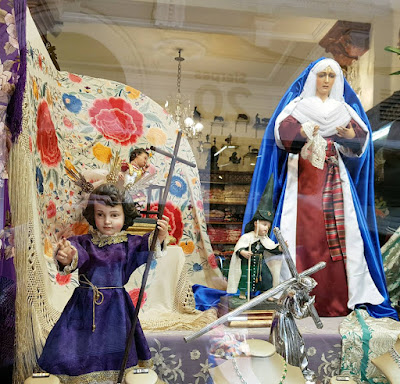Cadiz has a long history as a seaport. It was founded in about 1100 BC by the Phoenicians. Inhabitants of Cadiz are known as Gaditanos after the original Phoenician name Gadir.
England in its various wars with Spain has bombarded Cadiz several times, for example by Drake who claimed to have “Singed the King of Spain’s beard” and Nelson at the time of Trafalgar. However, we didn’t see any evidence of these attacks.
The guidebook says the wealthiest period for Cadiz was from the 17th century after the river port of Seville silted up and that trade then went through Cadiz, particularly the gold and silver plundered from the New World. The cathedral owes its redevelopment to that wealth, originally a mosque, then a 13th century church before being reconstructed lavishly as a cathedral.It’s a stiff climb but we get to the top just as one of the
seven bells is striking. The photo is a non-striking bell:
As you would expect, the views are panoramic and the good
news is that there’s no sign on the horizon of English galleons bent on
revenge.
After descending (more easily!) to the base of the bell tower we now enter the cathedral itself. It’s full of the usual images, gold alterpieces and marble pillars, but magnificent nonetheless.
Once out of the cathedral, we walked through the fishermen’s
district to one of the city gates set in the old city walls.
The gate led to a causeway linking with a fort that would
have dominated the seaways into the city but now looks unimpressive. Nice beach
though.
This is part of the old jail. From the outside, it could be
modern day apartments, so not looking too austere. I’m sure the reality was
very different.
So what’s this, a pile of junk fly-tipped over the
breakwater wall? Looking closely, they are rough and ready cat boxes. There are
several large colonies on the sea side of the breakwater with notices to say that
the cats are neutered and aren’t doing any harm there. Presumably, the cats’
guardians are a charity with official permission for the moggytown. It’s an
interesting way to deal with Spain’s feral cat population.
These are the gates to the old town, set in the old walls, now
claimed totally by the heavy traffic entering and leaving the city.
The convent of Santo Domingo was finished in 1650 and the
tower is made out of Cadiz oyster stone. Here’s a photo of the tower – very
nice- but we couldn’t see how oyster stone was anything special..
The last photo is a good example of too much information!
The stone wall along the front is part of the Roman theatre. The tower on the
right is the cathedral tower that we climbed. There’s another one to the left,
and then the cathedral dome that’s supposed to shimmer like gold except looks like
a cold fried egg. Research revealed no info on the multi-coloured pyramid.
There were other significant buildings and museums in Cadiz
that we couldn’t fit in on a day trip. In just over an hour we arrive back in
Sardine City Campsite, Seville, an easy 65 miles on good motorways.










































